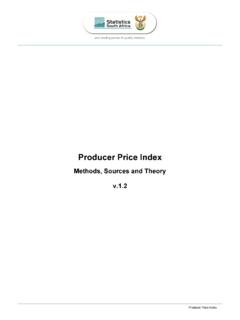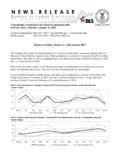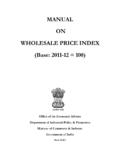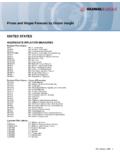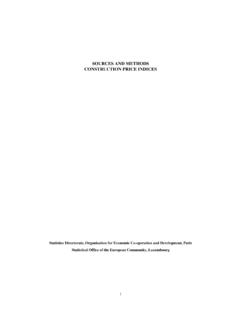Transcription of The pharmaceutical industry: an overview of CPI, PPI, and ...
1 1 The pharmaceutical industry : an overview of CPI, PPI, and IPP methodology Introduction The pharmaceutical industry plays a major and growing role in the United States economy, with both the consumption and the production of its products. Total value of consumption of pharmaceutical drugs in 2009 was $300 billion, or about 40 percent of the worldwide market share, and reflected a 37-percent increase since The total value of shipments by domestic producers in 2009 was $142 billion, with $46 billion in estimated exports. The 2009 value of imports was $81 billion, and represented a 65-percent jump over the value in Less expensive generic equivalents account for three-quarters of prescriptions filled, a figure that is climbing quickly because of a wave of patent expirations.
2 Despite the high volume, generics account for only one-quarter of sales in the drug market. The United States relies on imports to meet the demand for prescription drugs. By volume, 40 percent of the finished pharmaceuticals consumed in the United States are imported; this figure is close to 80 percent for active and bulk pharmaceutical ingredients in these finished drugs. By value, the United States still leads the world in pharmaceutical production, accounting for 39 percent of world production, followed by the United Kingdom, Germany, France, and Japan. The Consumer Price Index (CPI), producer price Index (PPI), and Import/Export Price Index (IPP) all have pharmaceutical indexes, but there are fundamental differences in the form and function of each index.
3 These differences include the composition of the set of drugs sampled and the types of price collected. The CPI records drug price changes from the perspective of the retail consumer. The PPI tracks the first price received by the manufacturers themselves. The IPP measures changes in the import and export prices of pharmaceutical products. These indexes collectively span the value chain, complementing one another and providing insight into a dynamic and complex Comparison of CPI-PPI-IPP pharmaceutical indexes This summary briefly describes the three BLS price programs and their respective methods for calculating the pharmaceutical inflation monitors.
4 The following table highlights some of the main characteristics of the three programs approaches to constructing drug price indexes. The table is followed by a more detailed narrative. 1 IMS Health MIDAS report, Sept 2009, via Generic pharmaceutical Association (GPhA). 2 The value of 2009 domestic production comes from the Census Bureau s Annual Survey of Manufactures, while the value of imports and exports is reported by the Census Bureau s Foreign Trade Division. For more information, see and 3 PPI also publishes an index that measures the cost of the service that retail pharmacies provide in disseminating pharmaceuticals to customers.
5 This margin index measures the retail service, not the prices of prescriptions or over-the-counter drugs themselves (the main subject of this document). For more information on retail trade PPIs, see 2 Table 1. Comparison of CPI, PPI, and IPP pharmaceutical Indexes4 Characteristic CPI PPI IPP Official publication title Prescription drugs pharmaceutical preparations pharmaceutical products Relative importance values percent of CPI-US All Items percent of PPI percent of Finished Goods PPI percent of all imports; percent of all exports Does the program produce an index exclusively for prescription drugs?
6 Yes Yes No Index break outs below the prescription drug level None currently available 8 broad therapeutic categories as well as 28 detailed therapeutic class indexes N/A Average time between new samples 4 years5 5 7 years 2 years Are supplemental samples used to introduce new products? No Yes, annually No Type of price Transaction price received by the pharmacy Manufacturer s first transaction price Import/export transaction price at the border Coverage/Scope Physician-prescribed prescription and nonprescription drugs dispensed via pharmacies (excludes physician and hospital administered drugs) Prescription and nonprescription drugs produced in the (excluding Puerto Rico)
7 For all channels of distribution pharmaceutical products imported/exported from the United States (including Puerto Rico), inclusive of prescription and non-prescription drugs, as well as other medicaments Index focal point Consumer Goods-producing industry international trade Is there a revision period for index data? No Yes Final indexes are released 4 months after preliminary publication Yes Final indexes are released for up to 4 months after preliminary publication 4 New outlets and drugs are initiated twice a year, constantly refreshing the prescription drug sample.
8 Roughly 25 percent of the item and outlet sample is refreshed each year. For more information, refer to the Item Sampling section on page 9. 5 New outlets and drugs are initiated twice a year, constantly refreshing the prescription drug sample. Roughly 25 percent of the item and outlet sample is refreshed each year. For more information, refer to the section titled Item Sampling on page 8. 3 The main responsibilities of the CPI, PPI, and IPP This section briefly highlights the purpose, high-level design, and uses of the data produced by the CPI, PPI, and IPP. CPI The CPI is a measure of the average change over time in the prices of consumer items that people purchase for day-to-day living, such as food, clothing, shelter, and medical services.
9 The monthly movement in the CPI derives from weighted averages of the price changes of the items in its sample. In the CPI, the urban portion of the United States is divided into 38 geographic areas called index areas, and the set of all goods and services purchased by consumers is divided into 211 categories called item strata. This results in 8,018 item-area combinations (38 geographic areas multiplied by the 211 item strata). The CPI is calculated in two stages. The first stage is the calculation of basic indexes, which show the average price change of the items within each of the 8,018 CPI item-area combinations. For example, the prescription drug index for the Boston CPI area is a basic index.
10 The weights for the first stage come from the sampling frame for the category in the area. At the second stage, aggregate indexes are produced by averaging across subsets of the 8,018 CPI item-area combinations. The weights for the second stage are derived from reported expenditures from the Consumer Expenditure Survey (CE), which are updated every 2 years. The aggregate indexes are the higher level indexes; for example, the all-items index for Boston is an average of all of the area s 211 basic indexes. Similarly, the aggregate index for prescription drugs is an average of the basic indexes for prescription drugs in each of the 38 index areas.











